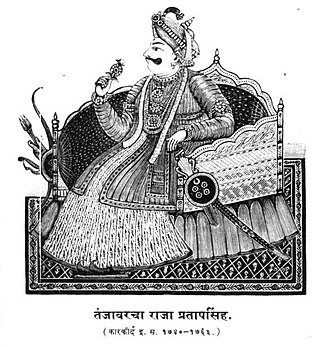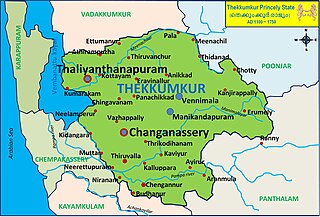
The Kingdom of Travancore, also known as the Kingdom of Thiruvithamkoor or later as Travancore State, was a kingdom that lasted from c. 1729 until 1949. It was ruled by the Travancore Royal Family from Padmanabhapuram, and later Thiruvananthapuram. At its zenith, the kingdom covered most of the south of modern-day Kerala and the southernmost part of modern-day Tamil Nadu with the Thachudaya Kaimal's enclave of Irinjalakuda Koodalmanikyam temple in the neighbouring Kingdom of Cochin. However Tangasseri area of Kollam city and Anchuthengu near Attingal in Thiruvananthapuram were parts of British India.

Anizham Thirunal Marthanda Varma was the founding monarch of the southern Indian Kingdom of Travancore from 1729 until his death in 1758. He was succeeded by Rama Varma (1758–98).

The Battle of Colachel was fought on 10 August 1741 [O.S. 31 July 1741] between the Indian kingdom of Travancore and the Dutch East India Company. During the Travancore-Dutch War, King Marthanda Varma's (1729–1758) forces defeated the Dutch East India Company's forces led by Admiral Eustachius De Lannoy on 10 August 1741. The Dutch never recovered from the defeat and no longer posed a large colonial threat to India. Travancore triumphed in the war thanks to the exceptional military efforts of the Travancore Nair Brigade at sea, along with the leadership of three Nair commanders—Arumukhan Pilla, Nanu Pilla, and Chembaka Raman Pilla—on land. Though in the war with Kayamkulam a regiment of Maravar from Tinnevelly under Ponnan Pandya Tevar also co-operated. It was the same army that defeated the Dutch at Colachel, where also the military genius of Ramayyan, not to speak of that of the Maharaja, was in conspicuous evidence.

Devasahayam Pillai or Mar Lazarus Sahada was an Indian layman and martyr of the Catholic Church. He was canonized as a saint of the church by Pope Francis on 15 May 2022.

Rama Varma I often referred to as Dharma Raja, was the Maharajah of Travancore from 1758 until his death in 1798. He succeeded his uncle Marthanda Varma, who is credited with the title of "maker of modern Travancore". During his reign Dharma Raja not only retained all the territories his predecessor had gained but administered the kingdom with success. He was addressed as Dharma Raja on account of his strict adherence to Dharma Sastra, the Hindu principles of justice by providing asylum to thousands of Hindus and Christians fleeing Malabar during the Mysorean conquest of Malabar.

The Travancore–Dutch War was a war between the Dutch East India Company (VOC) and the Indian kingdom of Travancore, culminating in the Battle of Colachel in 1741. Travancore won the war with the notable military service of fishermen community at the sea and seashore while Ananthapadmanabhan as commander in chief of the army at the land.

The Carnatic Sultanate was a kingdom in South India between about 1690 and 1855, and was under the legal purview of the Nizam of Hyderabad, until their demise. They initially had their capital at Arcot in the present-day Indian state of Tamil Nadu. Their rule is an important period in the history of the Carnatic and Coromandel Coast regions, in which the Mughal Empire gave way to the rising influence of the Maratha Empire, and later the emergence of the British Raj.

The Kingdom of Thekkumkur was an independent kingdom in the southern part of Kerala in India from 1103 CE until 1750 CE. It was ruled by the Thekkumkur Royal Family. Thekkumkur lies between the Meenachil River and the Pamba River, from the Western Ghats to the Vembanad Kayal. Thekkumkur emerged as a result of administrative changes in the princely states at the end of the Chera Kulasekhara dynasty of Mahodayapuram. The literal meaning of the title is the southern regent and the attribute southern distinguished them from another kingdom known as Vadakkumkur which bordered it in the northern side. The royal household, Thekkumkur Kovilakam, were at Vennimala and Manikandapuram near Puthuppally, later it shifted to Neerazhi Palace at Puzhavathu of Changanassery and Thalilkotta at Thaliyanthanapuram (Kottayam).

Muhammad Ali Khan Wallajah, or Muhammed Ali, Wallajah, was the Nawab of the Carnatic from 1749 until his death in 1795. He declared himself Nawab in 1749. This position was disputed between Wallajah and Chanda Sahib. In 1752, after several clashes, Chanda Sahib's forces and his French allies were expelled from Arcot, officially declaring Wallajah as Nawab on 26 August 1765. His reign was recognised by Mughal emperor Shah Alam II.

Chanda Sahib was a subject of the Carnatic Sultanate between 1749 and 1752. He was the son-in-law of the Nawab of Carnatic Dost Ali Khan, under whom he was a Dewan. An ally of the French, he was initially supported by Joseph François Dupleix during the Carnatic Wars. He annexed the Madurai Nayaks and was declared Nawab, bringing Tanjore and Tinnevelly into the dominions of the Mughal Empire.
Sa'adatullah Khan II a.k.a. Muhammad Sayyid was Nawab of Arcot, who was a younger son of Safdar Ali Khan.

Eustachius Benedictus de Lannoy was a skilled military strategist and commander of the Travancore army, under Maharaja Marthanda Varma.

)Ramayyan Dalawa was the Dalawa of Travancore state, India, during 1737 and 1756 and was responsible for the consolidation and expansion of that kingdom after the defeat of the Dutch at the 1741 Battle of Colachel during the reign of Maharajah Marthanda Varma, the creator of modern Travancore.

Pratap Singh Bhonsle or Pratapsinha was the Maratha ruler of Thanjavur of the Bhonsle dynasty from 1739 to 1763. His rise to power followed three years of anarchy and civil war and restored the state to its previous greatness. His reign witnessed the Carnatic Wars and the Seven Years' War.

The Travancore royal family was the ruling house of the Kingdom of Travancore. The Travancore royal family signed a treaty with the British in 1788, thereby adopting British dominance. Later, in 1805, they revised the treaty, leading to a diminution of royal authority and the loss of political independence for Travancore. They had to give up their ruling rights over the common people in 1949 when Travancore were forced to merge with Independent India and their political pension privileges were abolished in 1971.

The siege of Trichinopoly was part of an extended series of conflicts between the Nizam of Hyderabad and the Maratha Empire for control of the Carnatic region. On 29 August 1743, after a six-month siege, Murari Rao surrendered, giving Nizam ul Mulk (Nizam) the suzerainty of Trichinopoly. By the end of 1743, the Nizam had regained full control of Deccan. This stopped the Maratha interference in the region and ended their hegemony over the Carnatic. The Nizam resolved the internal conflicts among the regional hereditary nobles (Nawabs) for the seat of governor (Subedar) of Arcot State, and monitored the activities of the British East India company and French East India Company by limiting their access to ports and trading.

Tiruchirappalli is believed to be of great antiquity and has been ruled by the Early Cholas, Mutharaiyars Early Pandyas, Pallavas, Medieval Cholas, Later Cholas, Later Pandyas, Delhi Sultanate, Ma'bar Sultanate, Vijayanagar Empire, Nayak Dynasty, the Carnatic state and the British at different times. The archaeologically important town of Uraiyur which served as the capital of the Early Cholas is a Neighborhood of Tiruchirapalli.

The Battle of Changanacherry was a battle between the kingdoms of Thekkumkur and Travancore in September 1749. Defeat in this decisive battle led to Thekkumkur losing its dominance and expanding the Tranvancore empire to the southern border of the river Meenachilar.

Aditya Varma Manikandan popularly known as Aditya Varman, was the last ruling Maharaja of the Princely State of Thekkumkur. He was the ruler until September 1749 when the king of Travancore Anizham Thirunal Marthanda Varma ousted him from Neerazi Palace at the Battle of Changanassery. Thekkumkur kings were known as Manikandan. The goddess was Cheruvally Bhagavathi in the space. The official residence of Sri Aditya Varma was Neerazi Palace.

















